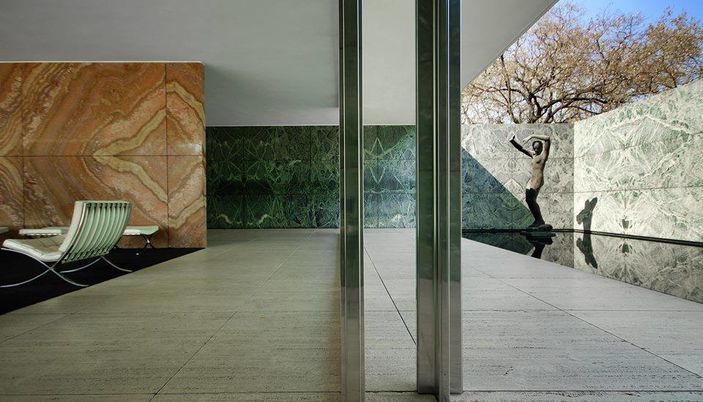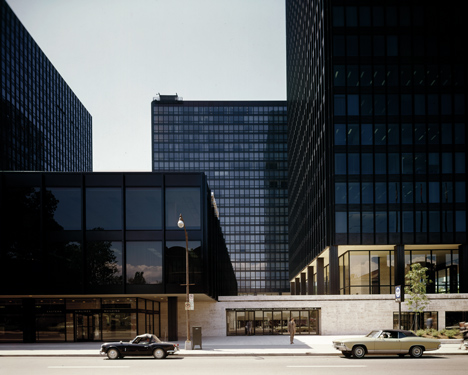"Has there ever been a place on earth where so many people of wealth and power have paid for and put up with so much architecture they detested?" - TOM WOLFE
Our story begins almost 100 years ago with the Bauhaus Boys, whose international style of architecture made our office buildings into glass-and-steel boxes, our art galleries look like garages and our schools look like shopping centres!
 |
| Left: First Bauhaus Seal x Karl-Peter Röhl (1919) Right: Seal of the Weimar State Bauhaus (1922) |
 |
| Walter Gropius, New YorkMarch 12, 1948 by Irving Penn |
"We have removed the divinity of art and architecture from the hands of the official art establishment, and it now resides with us, inside our compound. We no longer depend on the patronage of the nobility, the merchant class, the state, or any other parties for divine eminence. Henceforth anyone who wishes to bathe in art's glow must come here and accept the forms we have created. No alterations, special orders, or loud talk from the client permitted. We know best. We have exclusive possession of the true vision of art & architecture."
 |
| Dessau Bauhaus Building (1925/25) x Walter Gropius |
The School adopted a modern philosophy of education called Reformpädagogik: an activity-based curriculum with a hierarchy of apprentice, journeyman, and master. Some notable members included: Marcel Breuer, Wassily Kandinsky, Paul Klee, and Oskar Schlemmer. But don't mistake it for a Boy's Club, the students were 50/50 male & female, very progressive for the time. They weren't satisfied to be your run-of-the-mill School of Arts & Crafts. They yearned for that Total Work of Art... The Bauen...The Building.
Bauhaus was intent on creating forms that were decidedly "non-bourgeois". In fact, the way to throw shade on someone was to accuse them of being part of the Bourgeoisie. It held this sordid impurity, and was basically used as a catch-all for whatever you didn't like in the lives of outsiders, a fast-track to establishing moral superiority. Early in "The Battle to be The Least Bourgeois", Gropius suffered a devastating embarrassment at the First International Congress of Progressive Art in Düsseldorf (1922). At the time, he was a pushing the idea of craftsmanship: simple furniture & objects in wood or ceramic - handmade by honest workers. Immediately he got into it with Theo van Doesburg, a sassy Dutch manifesto writer. Theo was all like "OMG...who could even afford such luxurious, time-consuming, handcrafted pieces?? That's like, totally bourgeois. Ew." Then Gropius was like "Shit....yeah ok...I can see that now." Overnight he embraced technology and machine-made fabrication along with concrete, glass, steel and stucco.
 |
| Small Tea-Essence Pot (1924) x Marianne Brandt |
Once the American Architects finished their discount tour of Europe, they brought their Brave New Style back home to impress upon the Land of the Free. I can imagine Frank Lloyd Wright's annoyance at these pretentious ex-Pats (read: hipsters) waltzing back into town pushing their "International Style" when he had been there the whole time working on his "Prairie Style" (which to be fair was more appropriate for the U. S. of A.) America had emerged from the war on top of the world; no smoking rubble, no re-building from scratch, no bourgeoisie to be toppled... you want a home with a gigantic footprint? Take it, you earned it, soldier! That's freedom. Due to heavy pressure from the National Socialists, Bauhaus dissolved the school in 1933 but many of the prominent teachers took up residence state-side: Gropius and Breuer at Harvard, Mies at the Art Institute of Chicago, and Josef Albers at the famed Black Mountain College in North Carolina. There was even a "New Bauhaus" formed in Chicago in 1937.
 |
| Barcelona Pavilion (1928/9) x Mies van der Rohe |
In this manner, the "International Style" wedged its way into the American Design Lexicon. Even so, the Americans couldn't resist adorning and well, messing everything up, basically. Occupants were driven to the edge of sensory deprivation by the whiteness & lightness & cleanness & spareness of it all. They longed for antidotes of colour and texture, burying their obligatory white sofa in silk throw-pillows in rebellious shades of pink and tropical green. The architect would return and lecture them into removing the decor. I remember hearing a story once about Philip Johnson and Mies van der Rohe after designing the Great Glass Tower in Manhattan - the Seagram Building. They made the initial mistake of installing roller blinds that could be adjusted to whatever height you wanted. It drove them bananas to see their building from the exterior with the all the blinds creating a chaotic and disorganized sight line. Their solution? Blinds with only three fixed positions: open, closed or halfway.
Bauhaus: The Customer is Never Right.
------------------------------------------------------------------------------------------------------------------
Extra Credit Assignment for Montrealers: Check out two Mies van der Rohe Landmarks
------------------------------------------------------------------------------------------------------------------
 Westmount Square
Westmount Square 1 Westmount Square
Wesmount, QC

Gas Station Conversion
201 rue Berlioz
Verdun, QC
No comments:
Post a Comment